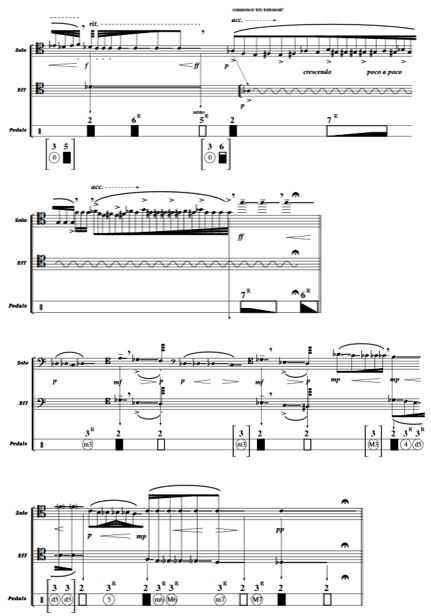In order for the musicians to be able to play your scores, you must indicate the information according to certain requirements defined by interpreters and composers who have already worked with this material.
Here is an example of a score:
© Alexander Mihalic - DNA
Important :
Each register is used for one piece or for a part of a piece.
This is important for the musician so that he can master the instrument and understand what he is playing in order to express your work musically.
Using the three staves
You will write in three staves.
The musician needs to have a clear idea of what sound he should produce and of how to produce it. He therefore needs to be able to repeat the sound like on any acoustic instrument, listening to what he is playing.
Here is what is written in the three staves :
1 – the acoustic instrument (classic notation)
2 – the sound effect (classic notation, possibly mixed/combined with graphics)
This staff must be readable and understandable in order to let the musician know what sound the composer wishes to obtain. The more you detail the resulting sound with classic notation, the better chances there are that the musician will correctly interpret your score.
3 – the “tablature” for the pedals. Here you should indicate the position of each pedal or their evolution in time.
The musician will perform the gestures according to these indications to obtain the resulting sound described in the second stave..
© Sergio Blardony - Cronica para entenderse con Io antiguo
Tablature for the pedals
Continuous pedals
To inform the musician on which pedal he needs to press and to what level, we represent symbolically a pedal as a rectangle more or less filled according to the pedal’s position. If the pedal is at its off position, the rectangle is white. If the pedal is pressed to its maximum, the square is entirely black. All intermediary positions are expressed visually. Here is an example with different positions:
At the same time you must indicate the number of the pedal on top of the rectangle to let the musician know which pedal to modify.
If you want to change a pedal continuously, you should indicate the curb in the rectangle in the score during the time needed. You can also indicate which foot (L, R) should play the the pedal next to the pedal number.
Notation of pitch changing
In case you want to indicate precise information - such as transposition interval, simply note the interval value in a cercle at the corresponding moment in the score.
Remind the pedals’ positions regularly
Always mark the position of all the pedals after a certain time or just before a moment of an important transformation. Reminders are noted in brackets:
It is in fact very difficult for the musician to reconstitute the pedals’ positions if only one of them is indicated. The best way of doing reminders is to resume the positions at the beginning of each line or at key moments for the rehearsing of the musical piece.
Keep in mind that the more precise and clear your score is, the better the chances are that it will be rehearsed and played correctly.



